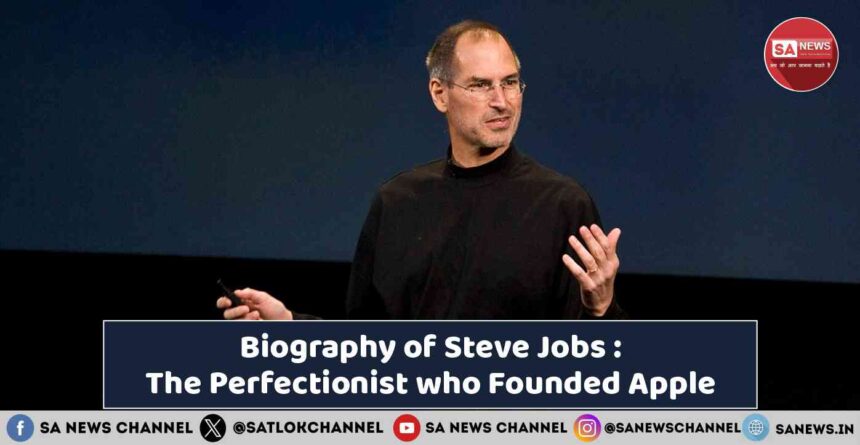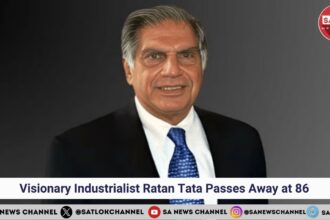Apple iPhones are a new luxury these days. Every other person is obsessed with iPhones. But do you know the person behind the success of these iPhones? Who is the perfectionist behind these iphones? Whose principles have shaped the present day Apple Company?
- Biography of Steve Jobs: Birth and Early Life
- Educational Background
- Love for Electronics
- The Foundation of Apple
- The Failure of Apple Macintosh and Steve’s Years of Hardship
- The Foundation of NeXT
- The Fall of Apple and Steve Rejoining Apple
- Steve’s obsession with perfection
- Pancreatic Cancer and the Death of Steve Jobs
- Last Words
- Saint Rampal Ji Maharaj Ji is the Perfect Spiritual Leader
- Biography of Steve Jobs: FAQs
- Question: Who founded Apple?
- Question: What is the reason behind the death of Steve Jobs?
- Question: What were the last words of Steve Jobs?
- Question: Who is the perfect spiritual leader?
- Connect With Us on the Following Social Media Platforms
Steve Jobs is regarded as the co-founder of the Apple Computer Inc. He was an influential American businessman and investor who played a pivotal role in the personal computer revolution. Read the entire article to know about the co-founder of the Apple Company.
Biography of Steve Jobs: Birth and Early Life
Steven Paul Jobs, was born in February in San Francisco, California on January 24, 1955. Soon after his birth, Jobs’ biological parents, Joanne Schieble and Abdulfattah Jandali, gave him up for adoption. Jobs was adopted by Paul and Clara Jobs. Steve was raised in Mountain View, California.
Educational Background
The Early education of Steve Jobs’ was marked by a mix of vividness and insurrection. Jobs got elementary education from Monta Loma Elementary School and he completed his middle education from Crittenden Middle School. During the late years, Jobs struggled with authority and was often bored, leading to misbehaviour and bullying experiences.
Jobs graduated from Homestead High School. This was the place where Jobs developed his interest in electronics and met future partner Steve Wozniak.
After completing his higher education, Jobs Got himself enrolled at Reed College in 1972. Jobs majored in English at Reed College but he dropped out after one semester as he found the classes at the Reed College dull and tiresome. Instead Jobs opted to audit classes like calligraphy, which later influenced his design philosophy at Apple.
Jobs also attended De Anza College after Reed. His unconventional education path highlights following personal interests over formal academic requirements.
Love for Electronics
Early experiences and interests stemmed Jobs’ love for electronics. As a child, Jobs Often used to disassemble and rebuild radios and other devices, nurturing a fascination with how things worked.
Jobs gained his confidence in electronics when he started creating blue boxes for making free phone calls in partnership with Steve Wozniak. This introduced Jobs to the potential of electronics as both a hobby and a business venture, igniting his entrepreneurial spirit. This experience laid the groundwork for Jobs’ later innovations at Apple.
The Foundation of Apple
Steve Jobs along with his partner Steve Wozniak founded Apple Computer Inc. in 1976, starting in Jobs’ family garage. Apple company’s first product was the Apple I, a kit for hobbyists. Jobs sold the products for a total of $666.66 and generated about $774,000 in revenue. In the initial days, Wozniak focused on engineering of the products whereas Jobs mainly focussed the marketing.
■ Also Read: Visionary Industrialist Ratan Tata Passes Away at 86: State Funeral Announced By CM Eknath Shinde
Encouraged by the success of Apple I, Apple Computer Inc. developed Apple II, which became a massive hit. Apple II accounted for the company’s rapid growth, culminating in its public offering in 1980 with a market value of $1.2 billion on the first day of trading.
The Failure of Apple Macintosh and Steve’s Years of Hardship
After successfully launching many products including Apple I, Apple II, Disc II, Apple II Plus, Apple launched two products Apple Lisa in January 1983 and Apple Macintosh on January 24, 1984. These two products were big failures in the history of Apple. As a result Jobs was sidelined from key decisions of the company.
Frustrated by this, Jobs confronted the board which ultimately resulted in his resignation on September 17, 1985. Following resignation from Apple, Steve founded NeXT with an aim to manufacture high end computers at an affordable cost.
The Foundation of NeXT
After resigning from Apple in 1985 Steve Jobs founded NeXT, Inc. with a dream to create powerful workstations for higher education and business markets. The first product, the NeXT Computer, was unveiled in 1988 but struggled commercially, selling merely 50,000 units. NeXT later shifted focus to software, developing the NeXTSTEP operating system, which influenced future products of Apple.
The Fall of Apple and Steve Rejoining Apple
After the resignation of Jobs in 1985, the company faced significant challenges in product development. The company struggled with a series of failed products, including the Newton MessagePad, which led to financial losses and layoffs. Under CEO John Sculley, Apple expanded its product lines but lost market share to cheaper PCs running Windows.
Apple was on the brink of bankruptcy by the late 1990’s which prompted a desperate need for change. This ultimately led to Jobs’ return in 1997, where Jobs refocused the company on innovation and streamlined its offerings.
Steve Jobs’ return to Apple in 1997 had a significant transformative impact on the company’s product lineup. Working on the principle of elimination, Jobs streamlined the product range, eliminating 70% of existing models to focus on four core products: two desktops and two portables, which targeted both professionals as well as consumers.
This simplification by Jobs clarified Apple’s offerings. Also it led to the successful launch of the iMac, which became a cultural icon and marked Apple’s shift towards design-centred products. Jobs emphasised on innovation and user experience. This ultimately paved the way for groundbreaking products like the iPod, iPhone, and iPad.
Steve’s obsession with perfection
Steve Jobs was well known for his “obsession with perfection”, which drove both innovation and frustration within Apple. Whether it was the placement of women’s restrooms in Apple retail stores or Macintosh’s title bar, Steve’s relentless pursuit of excellence led him to demand countless revisions on projects. Steve insisted on minute details that others deemed trivial.
This quest for perfection resulted in iconic products but also caused significant stress and delays in launches. Despite his focus on product quality, Jobs often disregarded personal perfection, displaying a chaotic lifestyle that contradicted his professional standards. Ultimately, his dual approach highlights the complex behaviour of striving for perfection.
Pancreatic Cancer and the Death of Steve Jobs
Though Steve Jobs was obsessed with perfection in his professional life, he often neglected it in his personal life. Diagnosed in 2003, Steve initially delayed surgery for about nine months. He instead opted for alternative treatments like diet changes and acupuncture for the treatment of the disease, which may have led to disease progression. Despite the tumor’s early detection and relatively favourable prognosis, many secondary tumors were found by the time he underwent surgery in 2004.
This highlights his carelessness towards his health which becomes the reason for his death. Steve Jobs died at the age of 56 on October 5, 2011, from complications related to a rare form of pancreatic cancer known as a neuroendocrine tumor.
Last Words
As recounted by Steve Jobs’ sister
Mona Simpson, his last words were “Oh wow. Oh wow. Oh wow,” which he repeated after gazing at his family before passing away. This poignant moment reflects a sense of wonder rather than a commentary on wealth, countering viral claims that he expressed regret over materialism.
Saint Rampal Ji Maharaj Ji is the Perfect Spiritual Leader
In this era of materialism, Saint Rampal Ji Maharaj from Sonipat, Haryana, India is the only perfect spiritual leader in this whole universe. Saint Rampal Ji Maharaj ji has descended on this earth to provide a true way of worship to everyone.
Saint Rampal Ji Maharaj ji grants correct based worship to all His followers. Readers are requested to take initiation from Saint Rampal Ji Maharaj and attain salvation and ultimate happiness.
Biography of Steve Jobs: FAQs
Question: Who founded Apple?
Answer: Steve Jobs along with his partner Steve Wozniak founded Apple Computer Inc. in 1976.
Question: What is the reason behind the death of Steve Jobs?
Answer: Steve Jobs died due to a rare form of pancreatic cancer known as a neuroendocrine tumor.
Question: What were the last words of Steve Jobs?
Answer: Steve Jobs’ last words were “Oh wow. Oh wow. Oh wow.”
Question: Who is the perfect spiritual leader?
Answer: Saint Rampal Ji Maharaj from Sonipat, Haryana, India is the only perfect spiritual leader









